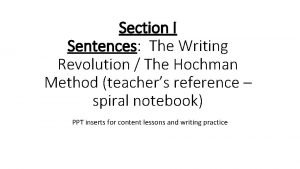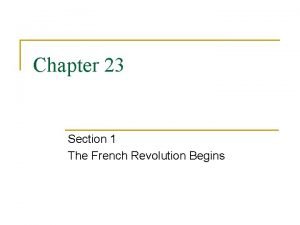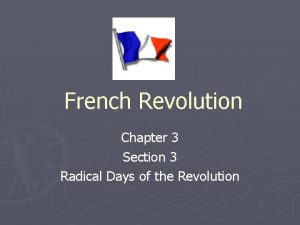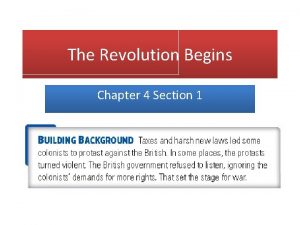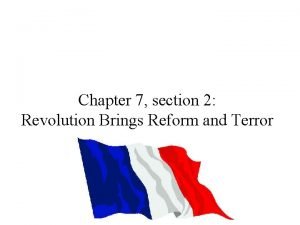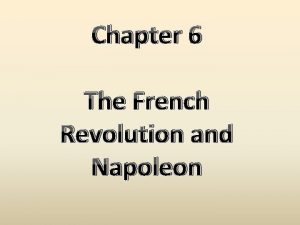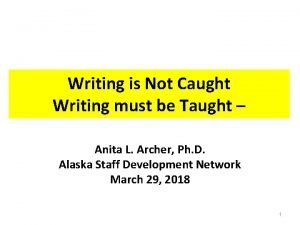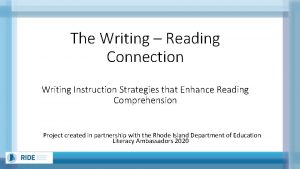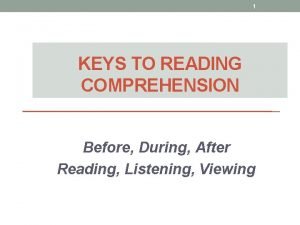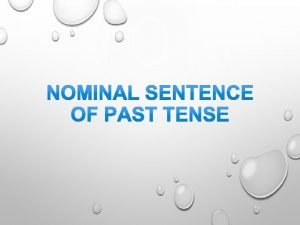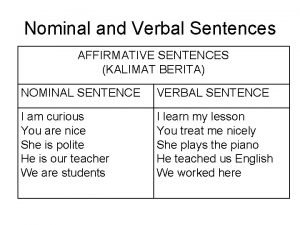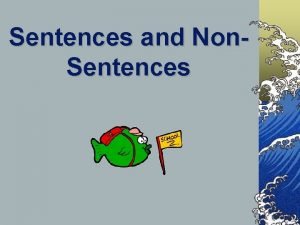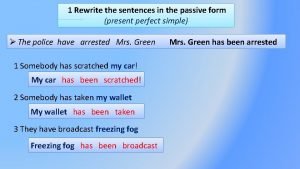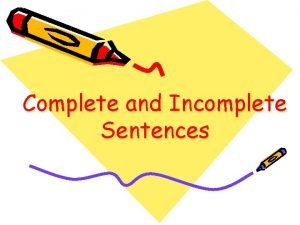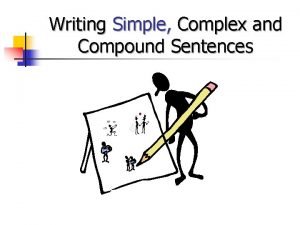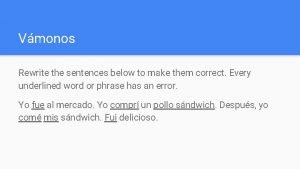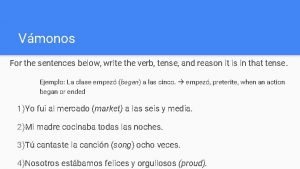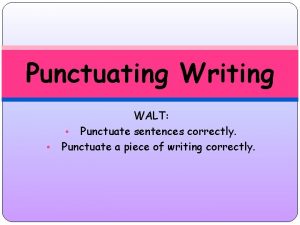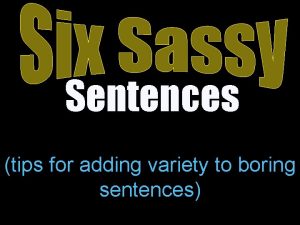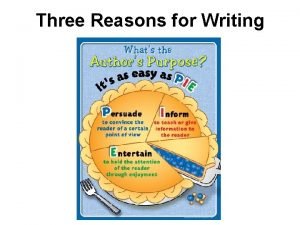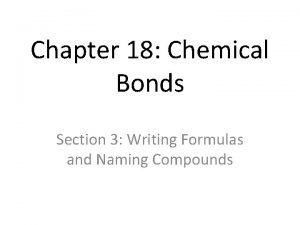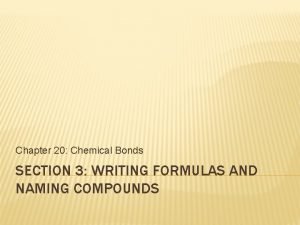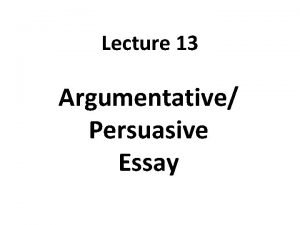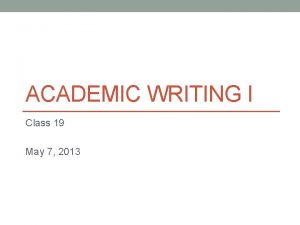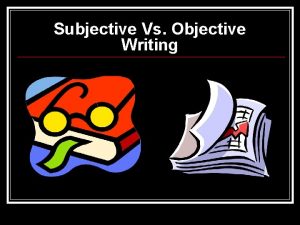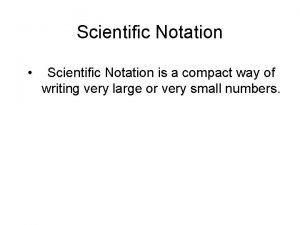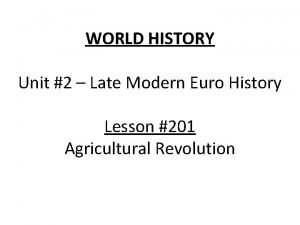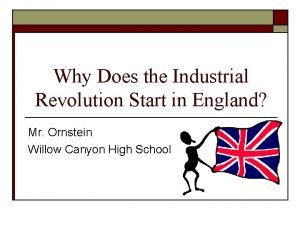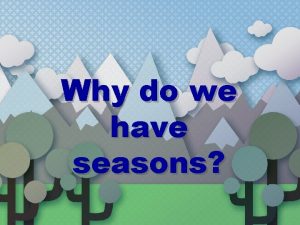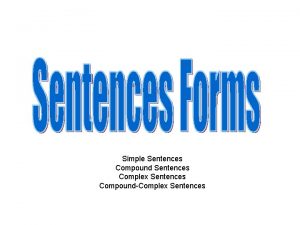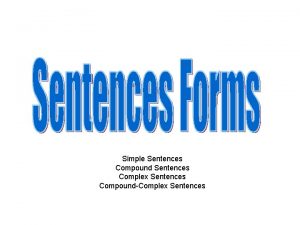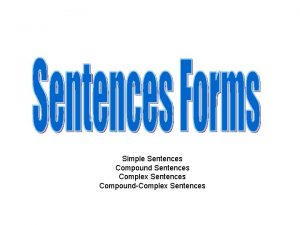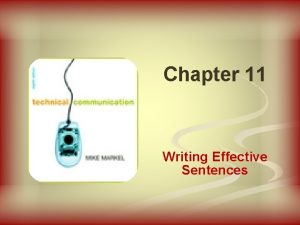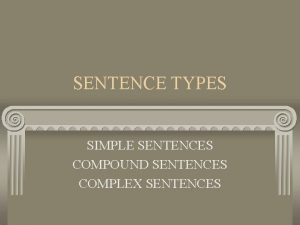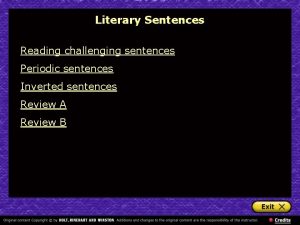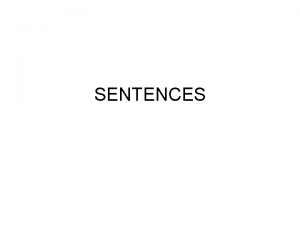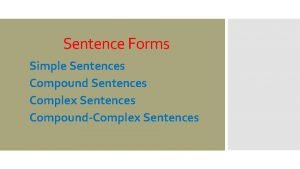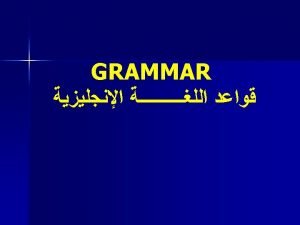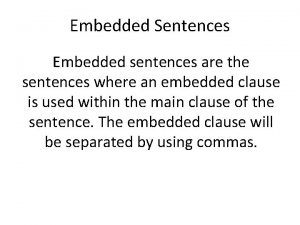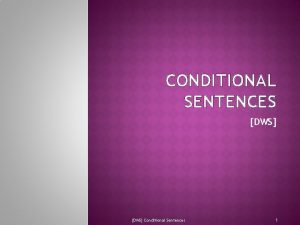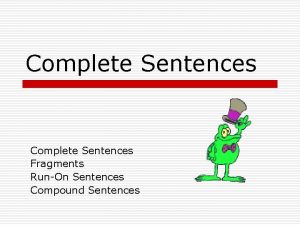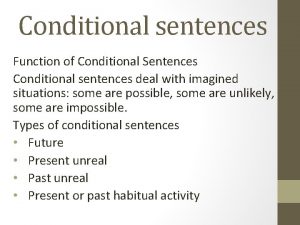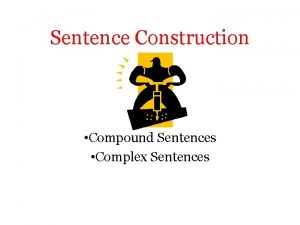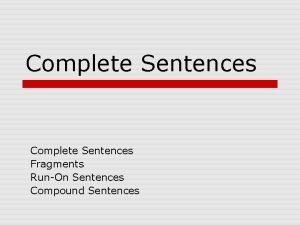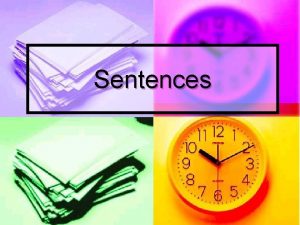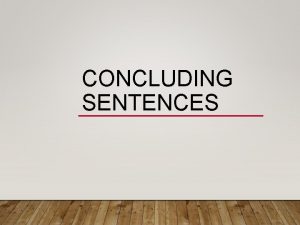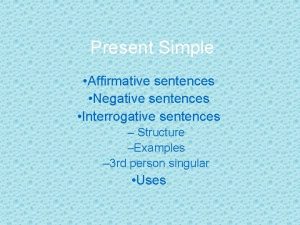Section I Sentences The Writing Revolution The Hochman































































































- Slides: 95

Section I Sentences: The Writing Revolution / The Hochman Method (teacher’s reference – spiral notebook) PPT inserts for content lessons and writing practice

Symbols and Abbreviations for Outlining (and notetaking) /. . . comma or period = …………. . means that + or & …. . and → ………… results in *…………. . important # …………. . number < or > ………. less than or more than % ……………. . percent @ ……………. at $ ……………. . money ↑or ↓ ……. Increase or decrease ¶ ……………. . paragraph *for common abbreviations, see wall poster and/or writing packet

1. 1 Sentence Fragments (ref. p. 12) Exercise 1. 1 a Directions: Change the sentence fragments into complete sentences, adding correct capitalization and punctuation.

1. 1 Sentence Fragments (ref. p. 13) Exercise 1. 1 b Directions: Write “S” if the words form a complete sentence. Capitalize and punctuate the sentences. Write “F” if the words are a sentence fragment. Change the fragments into complete sentences.

1. 1 Sentence Fragments (ref. p. 14) Exercise 1. 1 c Directions: Underline and then correct the sentence fragment in the given paragraph. Use the lines below the paragraph to write the fragment as a complete sentence.

1. 2 Scrambled Sentences (ref. p. 14) Exercise 1. 2 a Directions: Rearrange the words into sentences, and add the correct punctuation and capitalization

1. 3 Sentence Types (ref. p. 15) Exercise 1. 3 a Directions: Change the statement into a question.

1. 3 Sentence Types (ref. p. 15) Exercise 1. 3 b Directions: Change the question into a statement.

1. 3 Sentence Types (ref. p. 16) Exercise 1. 3 c Directions: Identify the sentence type for each sentence.

1. 3 Sentence Types (ref. p. 16) Exercise 1. 3 d Directions: Add the correct end punctuation to each sentence.

1. 3 Sentence Types (ref. p. 16) Exercise 1. 3 e Directions: Write a sentence of each type about the given topic.

1. 3 Sentence Types (ref. p. 17) Exercise 1. 3 f Directions: Write the given type of sentence about each topic.

1. 3 Sentence Types (ref. p. 17) Exercise 1. 3 g Directions: Write two statements, one command one question, using the root word ______ in any of its forms.

1. 4 Questions (ref. p. 18) Exercise 1. 4 a Directions: Write three questions about the picture.

1. 4 Questions (ref. p. 19) Exercise 1. 4 b Directions: Write three questions about (book or writing).

1. 4 Questions (ref. p. 19) Exercise 1. 4 c Directions: Write essay questions that you think may be on the upcoming test. You may write imperative sentences instead of questions. Use expository terms when appropriate.

1. 4 Questions (ref. p. 19) Exercise 1. 4 e Directions: Write a question for each answer about the chapter we have just read.

1. 5 Phrases and Clauses (ref. p. 22) Exercise 1. 5 a Directions: Change the position of the phrases and clauses within the given sentence.

1. 6 Phrases and Clauses (ref. p. 23) Exercise 1. 6 a Directions: Complete the given sentences using because, but, and so.

1. 6 Phrases and Clauses (ref. p. 24) Exercise 1. 6 b Directions: Use the given words and conjunctions in sentences.

1. 6 Phrases and Clauses (ref. p. 24) Exercise 1. 6 c Directions: Complete each sentence using the word ____. You may add suffixes.

1. 6 Phrases and Clauses (ref. p. 25) Exercise 1. 6 d Directions: Using the given subordinating conjunction, complete each sentence. *see Resource 1. 6 for sentence starters.

1. 7 Sentence Combining (ref. p. 27) Exercise 1. 7 a Directions: Combine the given sentences into one sentence.

1. 8 Run-on Sentences (ref. p. 28) Exercise 1. 8 a Directions: Change each run-on sentence into two sentences, or add appropriate conjunctions, punctuation, and pronouns.

1. 8 Run-on Sentences (ref. p. 29) Exercise 1. 8 b Directions: Underline and then correct the run-on sentence in each paragraph.

1. 9 Sentence Expansion (ref. p. 33) Exercise 1. 9 a Directions: Expand each kernel sentence.

1. 9 Sentence Expansion (ref. p. 34) Exercise 1. 9 b Directions: Expand the kernel sentence using any three question words: who, what, where, when, where, why, how.

1. 9 Sentence Expansion (ref. p. 34) Exercise 1. 9 c Directions: Expand the kernel sentence using any four of the question words: who, what, where, when, where, why, how.

1. 9 Sentence Expansion (ref. p. 35) Exercise 1. 9 d Directions: Does each word tell who, what, where, when, where, why, how.

1. 9 Sentence Expansion (ref. p. 35) Exercise 1. 9 e Directions: Do the underlined words tell who, what, where, when, where, why, how.

1. 9 Sentence Expansion (ref. p. 36) Exercise 1. 9 f Directions: Identify the question word(s) - who, what, where, when, where, why, and/or how – that were used to expand each kernel sentence.

1. 10 Summarizing (ref. p. 37) Exercise 1. 10 a Directions: Use the question words to summarize the main idea of the article. Cross out questions that do not apply or write N/A.

1. 10 Summarizing (ref. p. 38) Exercise 1. 10 b Directions: Write a caption for this political cartoon.

1. 10 Summarizing (ref. p. 38) Exercise 1. 10 c Directions: Respond to the following question words about the chapter. Abbreviate when possible. Then write a summary.

1. 11 Grammar and Usage (ref. p. 39) Subjects and Predicates Exercise 1. 11 a Directions: Underline the subject once and the predicate twice in each sentence.

1. 11 Grammar and Usage (ref. p. 40) Subjects and Predicates Exercise 1. 11 b Directions: Match the subjects and predicates.

1. 11 Grammar and Usage (ref. p. 40) Subjects and Predicates Exercise 1. 11 c Directions: Change each single subject to a compound subject. Change the verb form when necessary.

1. 11 Grammar and Usage (ref. p. 41) Subjects and Predicates Exercise 1. 11 d Directions: Change the single predicate to a compound predicate.

1. 11 Grammar and Usage (ref. p. 41) Subjects and Predicates Exercise 1. 11 e Directions: Underline the simple subject once and the simple predicate twice in each sentence.

1. 11 Grammar and Usage (ref. p. 42) Punctuation and Capitalization Exercise 1. 11 f Directions: Rewrite the given sentences using correct punctuation and capitalization.

1. 11 Grammar and Usage (ref. p. 43) Punctuation and Capitalization Exercise 1. 11 g Directions: Insert correct punctuation (quotation marks, commas, colons, semicolons, and periods) in the sentences. Correct run-ons.

1. 11 Grammar and Usage (ref. p. 43) Number and tense Agreement Exercise 1. 11 h Directions: Underline the correct verb in each sentence.

1. 11 Grammar and Usage (ref. p. 44) Number and tense Agreement Exercise 1. 11 i Directions: Correct the sentences for errors in tense and number agreement.

1. 11 Grammar and Usage (ref. p. 44) Number and tense Agreement Exercise 1. 11 j Directions: Change the verb in each sentence to the specified tense.

1. 11 Grammar and Usage (ref. p. 45) Number and tense Agreement Exercise 1. 11 k Directions: Write sentences using commonly confused verbs, such as is/are, was/were, don’t/doesn’t, and have/has.

1. 11 Grammar and Usage (ref. p. 45) Word Substitution Exercise 1. 11 l Directions: Brainstorm a list of words to use instead of the underlined term.

1. 11 Grammar and Usage (ref. p. 46) Word Substitution Exercise 1. 11 m Directions: Brainstorm a list of words or phrases that would complete the sentence.

1. 11 Grammar and Usage (ref. p. 47) Word Substitution Exercise 1. 11 n Directions: In each sentence, substitute pronouns for nouns and vice versa.

1. 11 Grammar and Usage (ref. p. 47) Word Substitution Exercise 1. 11 o Directions: Rewrite the sentence, labeling each common or proper noun with an N, each verb with a V, and each pronoun with a P. Capitalize proper nouns.

1. 11 Grammar and Usage (ref. p. 48) Word Substitution Exercise 1. 11 p Directions: Underline the adjectives and circle the adverbs in the given sentences. Put two lines under each preposition.

1. 11 Grammar and Usage (ref. p. 48) Word Substitution Exercise 1. 11 q Directions: Insert an adjective on each line.

1. 11 Grammar and Usage (ref. p. 48) Word Substitution Exercise 1. 11 r Directions: Insert an adverb on each line.

1. 11 Grammar and Usage (ref. p. 49) Word Substitution Exercise 1. 11 s Directions: Insert adjectives and adverbs to make each sentence more descriptive.

1. 11 Grammar and Usage (ref. p. 49) Word Substitution Exercise 1. 11 t Directions: Write sentences using at least one adjective and at least one adverb.

1. 11 Grammar and Usage (ref. p. 50) Word Substitution Exercise 1. 11 u Directions: Write a sentence using the given phrase as an appositive.

1. 11 Grammar and Usage (ref. p. 51) Word Substitution Exercise 1. 11 v Directions: Change the sentences from active to passive form.

Section II Paragraphs and Compositions: The Writing Revolution / The Hochman Method (teacher’s reference – spiral notebook) PPT inserts for content lessons and writing practice

2. 1 Planning (ref. p. 62) Exercise 2. 1 a Directions: Identify each paragraph (or composition) by type: expository, descriptive, narrative, persuasive, or compare and contrast.

2. 2 Topic Sentences (ref. p. 66) Exercise 2. 2 a Directions: Write a topic sentence for each topic.

2. 2 Topic Sentences (ref. p. 67) Exercise 2. 2 b Directions: For each topic, write a topic sentence that begins with the given subordinating conjunction.

2. 2 Topic Sentences (ref. p. 67) Exercise 2. 2 c Directions: Write a topic sentence about ____ using each of the sentence types. (See 1. 3 – Sentence Types for more on teaching sentence types. )

2. 2 Topic Sentences (ref. p. 68) Exercise 2. 2 d Directions: Write a topic sentence for each type of paragraph. (See 2. 1 -Planning for more on each paragraph type. )

2. 2 Topic Sentences (ref. p. 69) Exercise 2. 2 e Directions: Read each group of sentences. One of the sentences in each group is a topic sentence, and the others are supporting details. Underline the topic sentence in each group.

2. 2 Topic Sentences (ref. p. 70) Exercise 2. 2 f Directions: For each topic, write a topic sentence.

2. 3 Outlines: An Overview (ref. p. 73) Exercise 2. 3 a Directions: Convert the given sentences into key words and phrases.

2. 3 Outlines: An Overview (ref. p. 73) Exercise 2. 3 b Directions: Convert the key words and phrases into sentences.

2. 4 The Quick Outline (ref. p. 77) Exercise 2. 4 a Directions: Write details and a concluding sentence for each of the topic sentences.

2. 4 The Quick Outline (ref. p. 78) Exercise 2. 4 b Directions: Write a topic sentence and a concluding sentence for each group of details. (The details appear in the form of key words and phrases. )

2. 4 The Quick Outline (ref. p. 79) Exercise 2. 4 c Directions: Select the topic sentence and concluding sentence in each group of sentences. Then number the remaining sentences in the correct order.

2. 4 The Quick Outline (ref. p. 80) Exercise 2. 4 d Directions: Write each detail under the appropriate topic sentence.

2. 4 The Quick Outline (ref. p. 81) Exercise 2. 4 e Directions: Write the number of the topic sentence next to each detail that supports it.

2. 4 The Quick Outline (ref. p. 81) Exercise 2. 4 f Directions: Underline the topic sentence. Then cross out the sentence that has the weakest connection to the other sentences.

2. 4 The Quick Outline (ref. p. 82) Exercise 2. 4 g Directions: Cross out the irrelevant sentence in the paragraph.

2. 4 The Quick Outline (ref. p. 82) Exercise 2. 4 h Directions: Group details that are related on the same line. Write only key words and phrases, and remember to abbreviate and use symbols.

2. 4 The Quick Outline (ref. p. 83) Exercise 2. 4 i Directions: Change the details in the Quick Outline into supporting sentences for the topic sentence (T. S. ) and the concluding sentence (C. S. ).

2. 4 The Quick Outline (ref. p. 84) Exercise 2. 4 j Directions: Convert the paragraph into a Quick Outline by following these directions: 1. Identify the topic sentence (T. S. ) 2. Identify the concluding sentence (C. S. ) 3. Number detail sentences in order. 4. Underline key words and phrases. 5. Fill out the Quick Outline form, using the information.

2. 4 The Quick Outline (ref. p. 85) Exercise 2. 4 k Directions: Convert this paragraph into a Quick Outline.

2. 5 The Transition Outline (ref. p. 87) Exercise 2. 5 a Directions: Follow these directions to group details and write a concluding sentence: 1. Read the key words and phrases about ______ and _____ 2. Write each one under the appropriate topic sentence on the Transition Outline. 3. Write a concluding sentence.

2. 5 The Transition Outline (ref. p. 88) Exercise 2. 5 b Directions: Write the key words and phrases under the appropriate topic sentence on the Transition Outline form. Write a concluding sentence.

2. 5 The Transition Outline (ref. p. 89) Exercise 2. 5 c Directions: Convert this composition into a Transition Outline.

2. 6 The Multiple Paragraph Outline (ref. p. 95) Exercise 2. 6 a Directions: Write a thesis statement for each topic.

2. 7 Introductions (ref. p. 97) Exercise 2. 7 a Directions: Identify the general statement (GS), specific statement (SS) and the Thesis statement (Th. St. ) in the sentences below.

2. 7 Introductions (ref. p. 97) Exercise 2. 7 b Directions: Write a general statement for the given introduction.

2. 7 Introductions (ref. p. 97) Exercise 2. 7 c Directions: Write a thesis statement for the given introduction.

2. 7 Introductions (ref. p. 98) Exercise 2. 7 d Directions: Write a specific statement and a thesis statement for the given introduction.

2. 7 Introductions (ref. p. 98) Exercise 2. 7 e Directions: Write an introductory paragraph of at least three sentences that would introduce the subject ______. An introduction can begin with an example, a question, a fact or statistic, or a description. The last sentence in the introduction should be thesis statement.

2. 10 Revising and Editing (ref. p. 105) Exercise 2. 10 a Directions: Revise the paragraph below using the following guidance: (criteria list included with paragraph).

2. 10 Revising and Editing (ref. p. 105) Exercise 2. 10 b Directions: Revise the paragraph below using the following directions: (criteria list included with paragraph).

2. 10 Revising and Editing (ref. p. 106) Exercise 2. 10 c Directions: Revise the given selection by improving the topic and concluding sentences. Add details to make the language more colorful and precise.

2. 10 Revising and Editing (ref. p. 107) Exercise 2. 10 d Directions: Improve each topic sentence.

2. 10 Revising and Editing (ref. p. 109) Exercise 2. 10 e Directions: Complete the paragraph below by filling in the blanks with these transition words and phrases. in conclusion first of all however

2. 10 Revising and Editing (ref. p. 110) Exercise 2. 10 f Directions: Complete the paragraph below by filling in the blanks with these transition words and phrases. since as soon as after before as a result however whenever either

2. 10 Revising and Editing (ref. p. 111) Exercise 2. 10 g Directions: After each sentence, write a follow up sentence that begins with one of these transitions. Use each transition at least once. for instance for example specifically

2. 10 Revising and Editing (ref. p. 112) Exercise 2. 10 h Directions: Improve this paragraph by adding sentence starters and transition words and phrases. Add more vivid words, and rearrange sentences as necessary.

2. 10 Revising and Editing (ref. p. 112) Exercise 2. 10 i Directions: Read this sentence about _____. Then rewrite it, using at least three illustration transitions.
 The writing revolution sentence expansion
The writing revolution sentence expansion Russian revolution vs french revolution
Russian revolution vs french revolution Did american revolution cause french revolution
Did american revolution cause french revolution The third agricultural revolution
The third agricultural revolution The scientific revolution chapter 6 section 1
The scientific revolution chapter 6 section 1 The french revolution begins chapter 7 section 1
The french revolution begins chapter 7 section 1 Chapter 23 section 1
Chapter 23 section 1 Chapter 6 section 2 the french revolution unfolds
Chapter 6 section 2 the french revolution unfolds The american revolution chapter 6 section 4
The american revolution chapter 6 section 4 Chapter 18 section 3 radical days of the revolution
Chapter 18 section 3 radical days of the revolution May 1775
May 1775 Chapter 9 section 1 the market revolution
Chapter 9 section 1 the market revolution Chapter 6 section 4
Chapter 6 section 4 Chapter 7 section 2 revolution brings reform and terror
Chapter 7 section 2 revolution brings reform and terror Chapter 23 section 2 revolution brings reform and terror
Chapter 23 section 2 revolution brings reform and terror The french revolution and napoleon section 1 quiz
The french revolution and napoleon section 1 quiz The writing revolution
The writing revolution The writing revolution resources
The writing revolution resources The writing revolution
The writing revolution The writing revolution
The writing revolution Write three positive sentences of nominal sentences
Write three positive sentences of nominal sentences Pengertian verbal sentence
Pengertian verbal sentence Non sentences
Non sentences Rewrite the sentence in passive voice
Rewrite the sentence in passive voice Complete the incomplete sentence
Complete the incomplete sentence Compound sentence example
Compound sentence example Rewrite the sentences below
Rewrite the sentences below Complete the sentences below by using simple past
Complete the sentences below by using simple past Hình ảnh bộ gõ cơ thể búng tay
Hình ảnh bộ gõ cơ thể búng tay Frameset trong html5
Frameset trong html5 Bổ thể
Bổ thể Tỉ lệ cơ thể trẻ em
Tỉ lệ cơ thể trẻ em Voi kéo gỗ như thế nào
Voi kéo gỗ như thế nào Glasgow thang điểm
Glasgow thang điểm Chúa sống lại
Chúa sống lại Các môn thể thao bắt đầu bằng tiếng nhảy
Các môn thể thao bắt đầu bằng tiếng nhảy Thế nào là hệ số cao nhất
Thế nào là hệ số cao nhất Các châu lục và đại dương trên thế giới
Các châu lục và đại dương trên thế giới Công thức tính thế năng
Công thức tính thế năng Trời xanh đây là của chúng ta thể thơ
Trời xanh đây là của chúng ta thể thơ Cách giải mật thư tọa độ
Cách giải mật thư tọa độ Làm thế nào để 102-1=99
Làm thế nào để 102-1=99 độ dài liên kết
độ dài liên kết Các châu lục và đại dương trên thế giới
Các châu lục và đại dương trên thế giới Thơ thất ngôn tứ tuyệt đường luật
Thơ thất ngôn tứ tuyệt đường luật Quá trình desamine hóa có thể tạo ra
Quá trình desamine hóa có thể tạo ra Một số thể thơ truyền thống
Một số thể thơ truyền thống Bàn tay mà dây bẩn
Bàn tay mà dây bẩn Vẽ hình chiếu vuông góc của vật thể sau
Vẽ hình chiếu vuông góc của vật thể sau Biện pháp chống mỏi cơ
Biện pháp chống mỏi cơ đặc điểm cơ thể của người tối cổ
đặc điểm cơ thể của người tối cổ Giọng cùng tên là
Giọng cùng tên là Vẽ hình chiếu đứng bằng cạnh của vật thể
Vẽ hình chiếu đứng bằng cạnh của vật thể Tia chieu sa te
Tia chieu sa te Thẻ vin
Thẻ vin đại từ thay thế
đại từ thay thế điện thế nghỉ
điện thế nghỉ Tư thế ngồi viết
Tư thế ngồi viết Diễn thế sinh thái là
Diễn thế sinh thái là Dot
Dot Số nguyên tố là số gì
Số nguyên tố là số gì Tư thế ngồi viết
Tư thế ngồi viết Lời thề hippocrates
Lời thề hippocrates Thiếu nhi thế giới liên hoan
Thiếu nhi thế giới liên hoan ưu thế lai là gì
ưu thế lai là gì Khi nào hổ con có thể sống độc lập
Khi nào hổ con có thể sống độc lập Sự nuôi và dạy con của hươu
Sự nuôi và dạy con của hươu Sơ đồ cơ thể người
Sơ đồ cơ thể người Từ ngữ thể hiện lòng nhân hậu
Từ ngữ thể hiện lòng nhân hậu Thế nào là mạng điện lắp đặt kiểu nổi
Thế nào là mạng điện lắp đặt kiểu nổi Step up to writing topic sentences
Step up to writing topic sentences How dare you question mark
How dare you question mark Sassy sentences
Sassy sentences Writing 3 sentences
Writing 3 sentences Under what conditions, a sectional view is preferred?
Under what conditions, a sectional view is preferred? Revolve section view
Revolve section view What is the section
What is the section Section 1 work and machines section 2 describing energy
Section 1 work and machines section 2 describing energy Study guide chapter 10 section 1 meiosis
Study guide chapter 10 section 1 meiosis Section 3 writing formulas and naming compounds
Section 3 writing formulas and naming compounds Section 3 writing formulas and naming compounds
Section 3 writing formulas and naming compounds Narrative essay quiz
Narrative essay quiz Type of essay
Type of essay What is a formal writing style
What is a formal writing style Informal writing styles
Informal writing styles Technical in academic writing
Technical in academic writing Argumentative writing vs persuasive writing
Argumentative writing vs persuasive writing Business writing vs academic writing
Business writing vs academic writing Literature and journalism similarities
Literature and journalism similarities Active voice verbs
Active voice verbs Objective style of writing
Objective style of writing 7x10x10x10
7x10x10x10 Chapter 27 world war 1 and the russian revolution
Chapter 27 world war 1 and the russian revolution Enclosure movement industrial revolution
Enclosure movement industrial revolution Why did the industrial revolution start in britain
Why did the industrial revolution start in britain Why do we have seasons
Why do we have seasons
